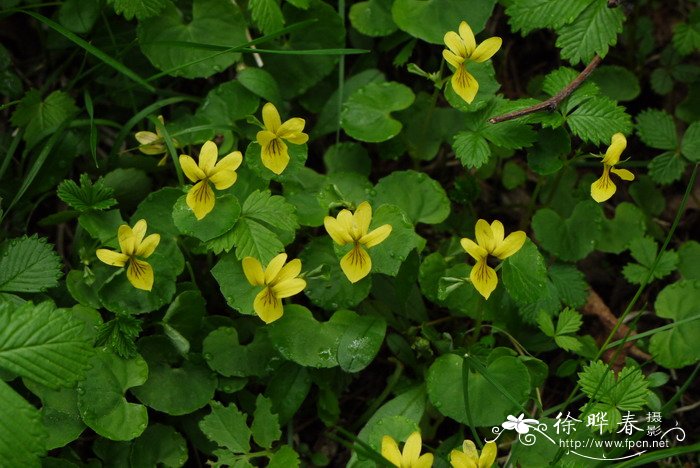双花堇菜Viola biflora
中文名(Chinese Name):双花堇菜
学名(Scientific Name):Viola biflora L.
英文名(English Common Name):arctic yellow violet
别名(Chinese Common Name):孪生堇菜
异名(Synonym):Viola biflora var. nudicaulis W. Becker Viola biflora var. platyphylla Franch. Viola nudicaulis (W. Becker) S. Y. Chen Viola tayemonii Hayata Viola kanoi Sasaki Viola biflora var. hirsuta W. Becker Viola biflora var. valdepilosa Hand.-Mazz. Chrysion biflorum (L.) Spach Dischidium biflorum (L.) Opiz
科属(Family & Genus):堇菜科(Violaceae)堇菜属
形态特征(Description):多年生草本。根状茎细或稍粗壮,垂直或斜生,具结节,有多数细根。地上茎较细弱,高10-25厘米,2或数条簇生,直立或斜升,具3 (-5) 节,通常无毛或幼茎上被疏柔毛。基生叶2至数枚,具长4-8厘米的长柄,叶片肾形、宽卵形或近圆形,长1-3厘米,宽1-4.5厘米,先端钝圆,基部深心形或心形,边缘具钝齿,上面散生短毛,下面无毛,有时两面被柔毛;茎生叶具短柄,叶柄无毛至被短毛,叶片较小;托叶与叶柄离生,卵形或卵状披针形,长3-6毫米,先端尖,全缘或疏生细齿。花黄色或淡黄色,在开花末期有时变淡白色;花梗细弱,长1-6厘米,上部有2枚披针形小苞片;萼片线状披针形或披针形,长3-4毫米,先端急尖,基部附属物极短,具膜质缘,无毛或中下部具短缘毛;花瓣长圆状倒卵形,长6-8毫米,具紫色脉纹,侧方花瓣里面无须毛,下方花瓣连距长约1厘米;距短筒状,长2-2.5毫米;下方雄蕊之距呈短角状;子房无毛,花柱棍棒状,基部微膝曲,上半部2深裂,裂片斜展,其间具明显的柱头孔。蒴果长圆状卵形,长4-7毫米,无毛。花果期5-9月。2n=12。
分布(Distribution):产东北、西南、内蒙古、河北、山西、陕西、甘肃、青海、新疆、山东、台湾、河南。生于海拔2500-4000米高山及亚高山地带草甸、灌丛或林缘、岩石缝隙间。欧亚、北美广布。
用途(Use):全草民间药用,能治跌打损伤。
引自中国植物志英文版:FOC Vol. 13 Page 105, 108
Viola biflora Linnaeus, Sp. Pl. 2: 936. 1753.
双花堇菜 shuang hua jin cai| Violaceae | Viola
Herbs perennial. Rhizome erect or obliquely ascending, slender or slightly robust, noded, with numerous rootlets. Stems 2 or several fasciculate, erect or obliquely ascending, 10-25 cm tall, slender, 3-5-noded, usually glabrous or sparsely puberulous when young. Basal leaves 2 to several; petiole 4-8 cm; leaf blade reniform, broadly ovate, or suborbicular to orbicular, 1-3 × 1-4.5 cm, abaxially glabrous, adaxially sparsely puberulous, sometimes puberulous on both surfaces, base cordate or subtruncate, margin obtusely dentate or shallowly repand-crenate, apex obtuse. Stipules free, ovate or ovate-lanceolate, 3-6 mm, margin entire or remotely denticulate, apex acute; cauline leaves shortly petiolate; petiole glabrous or puberulous; leaf blade smaller than basal ones. Flowers yellow, sometimes whitish at late anthesis; pedicels 1-6 cm, slender, 2-bracteolate at upper part; bracteoles lanceolate. Sepals linear-lanceolate or lanceolate, 3-4 mm, apex acute, basal auricles very short, margin membranous, glabrous or shortly ciliate in middle and lower parts. Petals oblong-obovate, 6-8 mm, purple veined, lateral ones inside not barbate, anterior one ca. 1 cm (spur included); spur shortly cylindric, 0.5-2.5 mm; spur of anterior stamens shortly triangular. Ovary glabrous; styles clavate, base slightly geniculate, deeply 2-lobed in upper half, lobes obliquely spreading, with a conspicuous stigma hole in between lobes. Capsule oblong-ovoid, 4-7 mm, glabrous.
Alpine or subalpine meadows and grassy slopes, thickets, forests, forest margins, rocks and rock crevices; 2500-4300 m. Gansu, Hebei, Heilongjiang, Henan, Jilin, Liaoning, Nei Mongol, Ningxia, Qinghai, Shaanxi, Shandong, Shanxi, Sichuan, Taiwan, Xinjiang, Xizang, Yunnan [Bhutan, NE India, Indonesia (N Sumatra), Japan, Kashmir, Korea, Malaysia, Mongolia, Myanmar, Nepal, Russia; Europe, North America].


(责任编辑:徐晔春)
学名(Scientific Name):Viola biflora L.
英文名(English Common Name):arctic yellow violet
别名(Chinese Common Name):孪生堇菜
异名(Synonym):Viola biflora var. nudicaulis W. Becker Viola biflora var. platyphylla Franch. Viola nudicaulis (W. Becker) S. Y. Chen Viola tayemonii Hayata Viola kanoi Sasaki Viola biflora var. hirsuta W. Becker Viola biflora var. valdepilosa Hand.-Mazz. Chrysion biflorum (L.) Spach Dischidium biflorum (L.) Opiz
科属(Family & Genus):堇菜科(Violaceae)堇菜属
形态特征(Description):多年生草本。根状茎细或稍粗壮,垂直或斜生,具结节,有多数细根。地上茎较细弱,高10-25厘米,2或数条簇生,直立或斜升,具3 (-5) 节,通常无毛或幼茎上被疏柔毛。基生叶2至数枚,具长4-8厘米的长柄,叶片肾形、宽卵形或近圆形,长1-3厘米,宽1-4.5厘米,先端钝圆,基部深心形或心形,边缘具钝齿,上面散生短毛,下面无毛,有时两面被柔毛;茎生叶具短柄,叶柄无毛至被短毛,叶片较小;托叶与叶柄离生,卵形或卵状披针形,长3-6毫米,先端尖,全缘或疏生细齿。花黄色或淡黄色,在开花末期有时变淡白色;花梗细弱,长1-6厘米,上部有2枚披针形小苞片;萼片线状披针形或披针形,长3-4毫米,先端急尖,基部附属物极短,具膜质缘,无毛或中下部具短缘毛;花瓣长圆状倒卵形,长6-8毫米,具紫色脉纹,侧方花瓣里面无须毛,下方花瓣连距长约1厘米;距短筒状,长2-2.5毫米;下方雄蕊之距呈短角状;子房无毛,花柱棍棒状,基部微膝曲,上半部2深裂,裂片斜展,其间具明显的柱头孔。蒴果长圆状卵形,长4-7毫米,无毛。花果期5-9月。2n=12。
分布(Distribution):产东北、西南、内蒙古、河北、山西、陕西、甘肃、青海、新疆、山东、台湾、河南。生于海拔2500-4000米高山及亚高山地带草甸、灌丛或林缘、岩石缝隙间。欧亚、北美广布。
用途(Use):全草民间药用,能治跌打损伤。
引自中国植物志英文版:FOC Vol. 13 Page 105, 108
Viola biflora Linnaeus, Sp. Pl. 2: 936. 1753.
双花堇菜 shuang hua jin cai| Violaceae | Viola
Herbs perennial. Rhizome erect or obliquely ascending, slender or slightly robust, noded, with numerous rootlets. Stems 2 or several fasciculate, erect or obliquely ascending, 10-25 cm tall, slender, 3-5-noded, usually glabrous or sparsely puberulous when young. Basal leaves 2 to several; petiole 4-8 cm; leaf blade reniform, broadly ovate, or suborbicular to orbicular, 1-3 × 1-4.5 cm, abaxially glabrous, adaxially sparsely puberulous, sometimes puberulous on both surfaces, base cordate or subtruncate, margin obtusely dentate or shallowly repand-crenate, apex obtuse. Stipules free, ovate or ovate-lanceolate, 3-6 mm, margin entire or remotely denticulate, apex acute; cauline leaves shortly petiolate; petiole glabrous or puberulous; leaf blade smaller than basal ones. Flowers yellow, sometimes whitish at late anthesis; pedicels 1-6 cm, slender, 2-bracteolate at upper part; bracteoles lanceolate. Sepals linear-lanceolate or lanceolate, 3-4 mm, apex acute, basal auricles very short, margin membranous, glabrous or shortly ciliate in middle and lower parts. Petals oblong-obovate, 6-8 mm, purple veined, lateral ones inside not barbate, anterior one ca. 1 cm (spur included); spur shortly cylindric, 0.5-2.5 mm; spur of anterior stamens shortly triangular. Ovary glabrous; styles clavate, base slightly geniculate, deeply 2-lobed in upper half, lobes obliquely spreading, with a conspicuous stigma hole in between lobes. Capsule oblong-ovoid, 4-7 mm, glabrous.
Alpine or subalpine meadows and grassy slopes, thickets, forests, forest margins, rocks and rock crevices; 2500-4300 m. Gansu, Hebei, Heilongjiang, Henan, Jilin, Liaoning, Nei Mongol, Ningxia, Qinghai, Shaanxi, Shandong, Shanxi, Sichuan, Taiwan, Xinjiang, Xizang, Yunnan [Bhutan, NE India, Indonesia (N Sumatra), Japan, Kashmir, Korea, Malaysia, Mongolia, Myanmar, Nepal, Russia; Europe, North America].
(责任编辑:徐晔春)
踩一下[0]

顶一下[0]